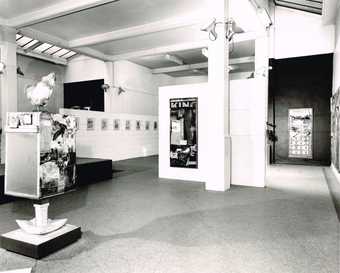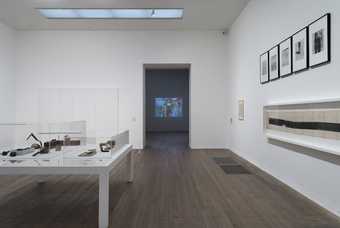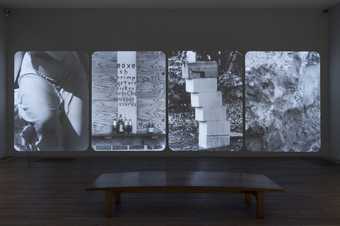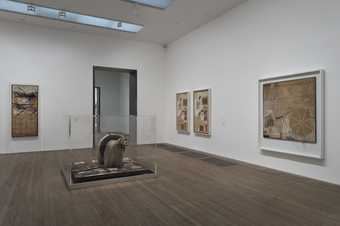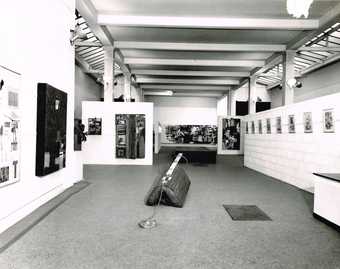Not Fade Away
Three quarters of a lifetime ago, in the early spring of 1964, I saw an exhibition at the Whitechapel Art Gallery. Who exactly was that person and what does he recall? And what does it mean to rehearse a teenage experience that’s been maturing for 50 years?
I gaze into this 8 x 10in black-and-white print of Robert Rauschenberg’s show. Archive! The visual modesty of the picture triggers much more than the generalised soft focus of my circumstances at that time. We relate to art and artists in the privacy of our minds, a sanctuary given to each of us, a place where feelings and thoughts, voices and smells, spaces and situations, sounds and signs create the amalgam of experience. It’s our own darkroom where a personal safe light guards over all this stuff as it gets fixed as memory. Settlement tanks. Magic.
A kindly teacher masterminded the visit. Anthony Ray was my Spanish teacher and perhaps more tolerant of the callow me through his friendship with the potter Gordon Baldwin. Gordon was the miracle man in the art room who was quietly, even rigorously, saving me from the confusions of being an early 1960s adolescent.
Our small group travelled up to London in Gordon’s Land Rover. We thought it was ‘cool’ (we may not yet have adopted the term), because Gordon had hand-painted his brand new khaki vehicle white: 2in brush/tin of Valspar, price eight-and-sixpence.
What could I have known about art? How would I know? There were a few other boys in our minuscule milieu, trading information much the same way as boys then swapped stamps. What was America? Where was it? I had a few conventional postcards from my parents in the late 1950s. I have no idea how they had crossed the Atlantic or for how long they were there, or where. ‘New England’, no doubt. I remember being fascinated by the regulatory size and text of American cards, the stamps with unkindly eagles, the unusual colour photography.
Children in the 1950s were taught pretty much as they had been in the 1930s, I now recognise. The 1940s were an ‘unplace’, almost unspoken. Maps were a big thing, more Empire than Commonwealth, but none the less an unusual spatial fiction of colours and coding for a young mind. I would have known what New England meant, but I was very firmly stuck in Old England. Being taken up to London was some kind of metaphor, getting out – if not ‘coming out’ (and homosexuality was still illegal).
We could sometimes watch television, two channels, in black-and-white with an erotic white dot at the centre of the screen when transmission ‘closed down’. We will all have seen the Sunday Times Colour Supplement (published from early 1962, I see), so unknowingly had a visual key to the locked-up delights of metropolitan life. Gordon would nail up ‘art pages’ on the pottery wall like Wild West wanted posters. In that secluded art laboratory for young minds, for sure we all knew that there were ‘ideas’ and ‘histories’ and ‘other cultures’. We probably did not use those terms, but we were given some colourful provocations. There was a small group of teachers and their families who represented the possibility of ‘modernity’. One of them, even, was close friends with John le Carré, already migrating from his previous identity as David Cornwell. I was too sheltered to see the wonderful import of that.
For us the overpowering friction, the sense of our imminent nuclear demise, all meant an unwavering ticker tape of names: Khrushchev, Dulles, Medgar Evers, Byron De La Beckwith, Gagarin, Guevara, Ho Chi Minh, Gary Powers, Castro, Mao, Nixon, Kennedy (who was assassinated on my father’s 43rd birthday). The sense of doom could be readily glamorised: Jackie, Elvis, Marilyn, but I am unlikely to have known very much of Warhol whose prescient ‘disaster pictures’ commence in 1963.
The adjectives which I may have wanted to use at the Rauschenberg show might have been: sumptuous, rude, crude, edgeless, flayed, interpenetrating, scenographic, irresponsible, un-responsible. These words would not have all been in my vocabulary. Those professionalised terms such as mixed media, installation, durational, projection had not yet sent open-minded artists off to the different locker rooms of the visual arts. White cubes. Black boxes.
Certainly, I saw an immense freedom being exercised, one I might now criticise because I believe it leads to ‘because you can’ art. Please please me. I admired, for sure, Rauschenberg’s assured improvisations and farmhand confidence. The way he redirected materials, reassigned images and processes. Its irreverence was clear to me, but that is something which I now see as the casual bedfellow of chic. Perhaps it was even then? I would have been far too suburban to comprehend some of its obvious messages, some which seem nearly illustrative now.
On the way home, I sat at the back of the Land Rover, unconstricted by seat belts. I remember leaning out over the tailgate and puzzling over the optics of witnessing the road surface at speed, wondering about perception...
Years later, I happened to be, after many previous visits, back in the United States. It was 12 September 2001 and I found myself being driven by my friend, the late poet Bill Berkson, over the Bay Bridge. ‘The thing about Bob’s work,’ said Bill of Rauschenberg, ‘is that he really understood the layout of newspapers, the rivalrous elements tied up in a simple geometry, all jostling for attention.’ We talked of other things besides. Empires was one of them.
* * *
Ten Lane Blacktop
Leaving the metropolis behind and walking into Tate’s Robert Rauschenberg exhibition on a Monday morning just before Christmas 2016 was strong meat…
‘Outside' paled away into humdrum contemporaneity.
Out-side.
‘Inside' swiftly alerted me to being 'modern’.
In-side.
The gallery as laboratory.
This show offers you a window into somebody's life’s endeavor. A life whose timing runs through a particularly accelerating vein of history. The early rooms are astonishingly European. The Texas-raised Rauschenberg loves printing and collage, he is quick to requisition things and press them into his service – the staple gun as artist’s weapon of choice, the child’s delight in the rubber stamp, the inkpad and the stencil, the thrill of the offprint.
He likes joining things up. His German teacher at Black Mountain Josef Albers’ encouragement to pay attention to ’the natural qualities of everyday materials’ is mentioned in a wall text and my experience of the show darts immediately to Josef Beuys. German Romanticism is never very far away. Some of Rauschenberg’s other theatrical companions could be the Belgian Marcel Broodthaers, or any of the Italian happenstance artists from arte povera. The 1952 photographic sequence Roman Steps offers a lover’s storyboard, something rendered deathly brittle by later generations clambering onto conceptualism’s trolley bus.
In these early rooms you find yourself gazing at some of the oldest things in the world: rocks, iron and timber. 'Elemental Sculptures’, a title to charm us. Meantime, many of my exhibition companions are attending to their audio guides or scrolling their smart phones, minding their families. We are, perhaps, all now an unwitting congregation in Rauschenberg's show, each one of us a troubadour with a role to perform, lightly scripted to play out ‘a public’. Watching each other in this show is a truly rewarding discipline, something so entirely different from the moral purpose of watching out for each other in life.
Mention of Black Mountain is a comforting way to be reminded about the history of the migration of artists. The magical energy of bringing un-likeminded folk together for a bigger shared purpose. Art schools as ‘gatherings’. I strongly recommend that you check the Black Mountain faculty list – eye popping…
Just like farms before they became monocultural, this show celebrates interconnections and the resourcefulness of crossovers, again and again and again. Attempting to explain Rauschenberg to an intrigued novice, I said: 'He could be using electrical flex to hang a picture and then he might recognise that he could wire up the loose ends to a bulb and a power source… Either/Or, or Neither. On or Off. Light or Dark.' You can follow this enterprising attitude through most of the materials and the technologies he adopts and adjusts.
For studious archivist types, though, this show generously offers ways to see that prescience, thoughtfulness and procedural brilliance were no less in play for Rauschenberg than the sheer charm of any of his sleights of hand. Just as much as the car tyre print made in collaboration with John Cage presages the road movie as a genre, a row of ‘stills’, so too is there a constant sense of the American Void and the imperative to populate it. This may involve the Great Indoors, staging events in vast abandoned halls in the metropolis, or countless redeployments of electrical and mechanical engineering, or liberating silkscreen printing to make ‘noise’. In the 1960s sections, the timely chatter of the military and the industrial is palpable. As gorgeous as it is awesome. Of course.
Boys’ stuff…
A great companion to go around this show with would be Marshall Mcluhan. The arts of 'news gathering’, editing, disseminating and casual conjunction are so very present. Just how smart would McLuhan’s phone be? Answers on a postcard…
I remember learning that television ‘news footage’ of Vietnam would typically be a week old when it came to be broadcast, the time it took to fly the film from Saigon to Paris and get it developed, edited and distributed. Stale, but freshened up. Not ‘new’ at all, but still the ‘news’. In the Tate show, archival copies of LIFE magazine already look no less archaic than the typography of ‘café’ or ‘journal’ in a fragment of a Braque collage from a century ago.
The enfilade of the Tate rooms, like carriages in a train, is a formal reminder of a typical Rauschenberg ploy, his affection for crates and boxes, calibrated slats and undulating corrugations. He loves a good void, and the militarised language of manuals and instructions, those typographic ornaments of the distributive trades.
Rauschenberg is a wonderful conjuror of abrasion and collision. A whole slew of American inventor artists spring to mind, each and every one Europe facing, Marcel Duchamp their part time agent and probable apothecary. Easy to contrast the stagecraft of the metropolitan Rauschenberg, I feel, with that obsessive near philatelist on suburban Utopia Parkway, Joseph Cornell – the Christmas cracker notions and potions of Cornell versus the rough and ready Rauschenberg. Dustbowl thrift overtaken by conspicuous salvage.
The warp and weft of celebrated relationships like Twombly and Johns, Cage and Cunningham are palpable throughout the show, jigsaws and missing jigsaw pieces, schemas and maps. Aristos and courts.
Other more oblique crosswires I had never thought of, the performative Bruce Nauman, say, or the workshoppy Man Ray – several times I was reminded of the steely sleuthing and watchmaker intelligence of Roman Redesky, who removed himself from Pittsburg to neon-lit Paris in 1924. An earlier artist with a printer's eye.
How easy to imagine Man Ray coveting the cornucopia of synthetic materials and processes which came to characterise post-war America, perhaps even tutting over the casual profligacy of the younger artist.
As I sat with others, bathing in the black and white slide projections of the Trisha Brown set, I could imagine what it would be like to walk down the street with Rauschenberg. It remains still one of the best ways to meet and spend time with others.
I can detect how he might negotiate urban humanity, his sense of the sidewalk (a much better word than ‘pavement’, though the French ‘trottoir’ is better still). To him the sidewalk must have been a fine piece of ‘polis’, a place to stage coming and going. While these private thoughts of mine are coalescing, I notice how very many wheeled vehicles there now are in this exhibition.
Although many are Rauschenberg’s own wheely images of truckling and trundling, most are infants in buggies, the youngest gallery ‘goers'. I can readily imagine Rauschenberg conspiring with his engineer friend Billy Kluver to set up a frequency to put them all at the bidding of a superior motor force. Rauschenberg’s Close Encounters version of a bumper car nursery. Tate Mayhem. Spontaneous delight.
My overall sense of Rauschenberg the man is of somebody of immense animal and mental agility. The artist's skill is to 'make luck'. This felicitous facility appears at the heart of Rauschenberg's show as a celebrated emblem.
Nimble is the watchword. Agile is the key.
How odd it is to have Monogram standing at the centre of the show, a taxidermied goat married to a truck tyre, now further embalmed in its museological cubic acrylic home. Animals in vitrines are really unremarkable. (Already seriously old – they had walk on parts in Ancient Egypt – they even helped originate 'museums'.) Rauschenberg's angora goat, though, we know as pure celebrity.
The consummate grace and agility of live animals is invoked by its antithesis, by the adroit way that Rauschenberg went about confecting this set piece more than half a century ago.
At Tate Modern, the once free wheeling, free standing goat reappears, but now embalmed. An acrylic cenotaph to go, museum fresh, a tomb.
Diagram/Monogram.

